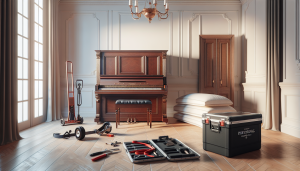Whether you’re in the midst of a home renovation, downsizing, or temporarily relocating, finding the right storage solution for your piano is crucial to ensure its safety and maintain its pristine condition. Pianos are delicate instruments that require proper care, even during periods of storage. In this guide, we’ll explore the key considerations and best practices for piano storage to keep your cherished instrument in top shape.
Contents
1. Climate-Controlled Environment
The most critical aspect of piano storage is maintaining a stable climate. Extremes in temperature and humidity can cause irreparable damage to your piano. When choosing a storage facility, opt for one that offers climate control. This ensures that the temperature and humidity remain within the safe range for pianos.
2. Choose the Right Storage Unit
Selecting the appropriate storage unit size is essential. Your piano should fit comfortably with enough space to move around it for maintenance or tuning. Consider your piano’s dimensions and choose a unit that accommodates it without excessive crowding.
3. Proper Covering
Before storing your piano, cover it with a breathable cloth or piano cover. This protects the finish from dust and potential scratches. Avoid using plastic covers, as they can trap moisture and harm the wood.
4. Elevate the Piano
To protect your piano from potential moisture on the floor, elevate it slightly. You can use wooden blocks or special piano dollies designed for storage.
5. Regular Inspection
Even in storage, your piano requires periodic inspection. Check for any signs of pests, mold, or mildew. Keep the storage unit clean and dry.
6. Maintain Tuning
Pianos tend to go out of tune over time, even in storage. It’s essential to schedule regular tuning sessions, typically every six to twelve months, to keep your piano in perfect pitch.
7. Avoid Direct Sunlight
If possible, position the piano away from direct sunlight. Sunlight can cause fading and damage to the piano’s finish.
8. Keep It Covered
While in storage, it’s a good idea to keep the keys covered to prevent dust accumulation and potential damage.
9. Professional Moving and Storage Services
When moving your piano to or from storage, consider professional piano movers who have the expertise and equipment to handle your instrument with care. They can ensure a smooth transition and minimize the risk of damage.
10. Insurance
Lastly, ensure that your piano is adequately insured during storage. Some storage facilities offer insurance, or you can check with your homeowner’s insurance provider for coverage options.
Conclusion
Piano storage is a crucial aspect of piano care, especially during times when your instrument is not in use. By selecting the right storage facility, maintaining a stable climate, and following these best practices, you can ensure that your piano remains in excellent condition for years to come.
At Utah Piano Movers, we understand the importance of proper piano storage. Whether you need short-term or long-term storage solutions, we offer secure climate-controlled storage options to protect your treasured instrument. Contact us at 801-396-7323 or visit our website to learn more about our piano storage services.




